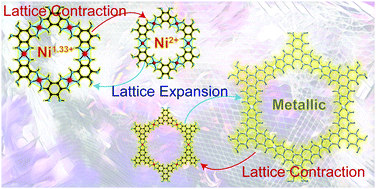Pressure-induced metallicity and piezoreductive transition of metal-centres in conductive 2-dimensional metal–organic frameworks†
Abstract
Due to their generally poor conductivity, metal–organic frameworks (MOFs) have been limited in electrical applications. The highest performing materials are two-dimensionally connected Ni3(hexaiminotriphenylene)2 and Ni3(hexaiminobenzene)2; both feature experimental conductivities exceeding 500 S m−1. From theory, both are predicted to be bulk metals but the former is known to be a semiconductor within a single monolayer. In this work we explore structural deformation as a route to augmenting the electronic properties of these two high performing materials. We show that, under hydrostatic negative pressure, metallicity can be installed in the Ni3(hexaiminotriphenylene)2 monolayer. Further, we predict a unique piezoreduction of metal ions and induced-magnetization in Ni3(hexaiminobenzene)2 due to the shift in energy of metal–ligand bonding and antibonding orbitals. These observations aid in our understanding of how MOFs conduct electricity and may also be used as a design principle in future MOF technologies.



 Please wait while we load your content...
Please wait while we load your content...